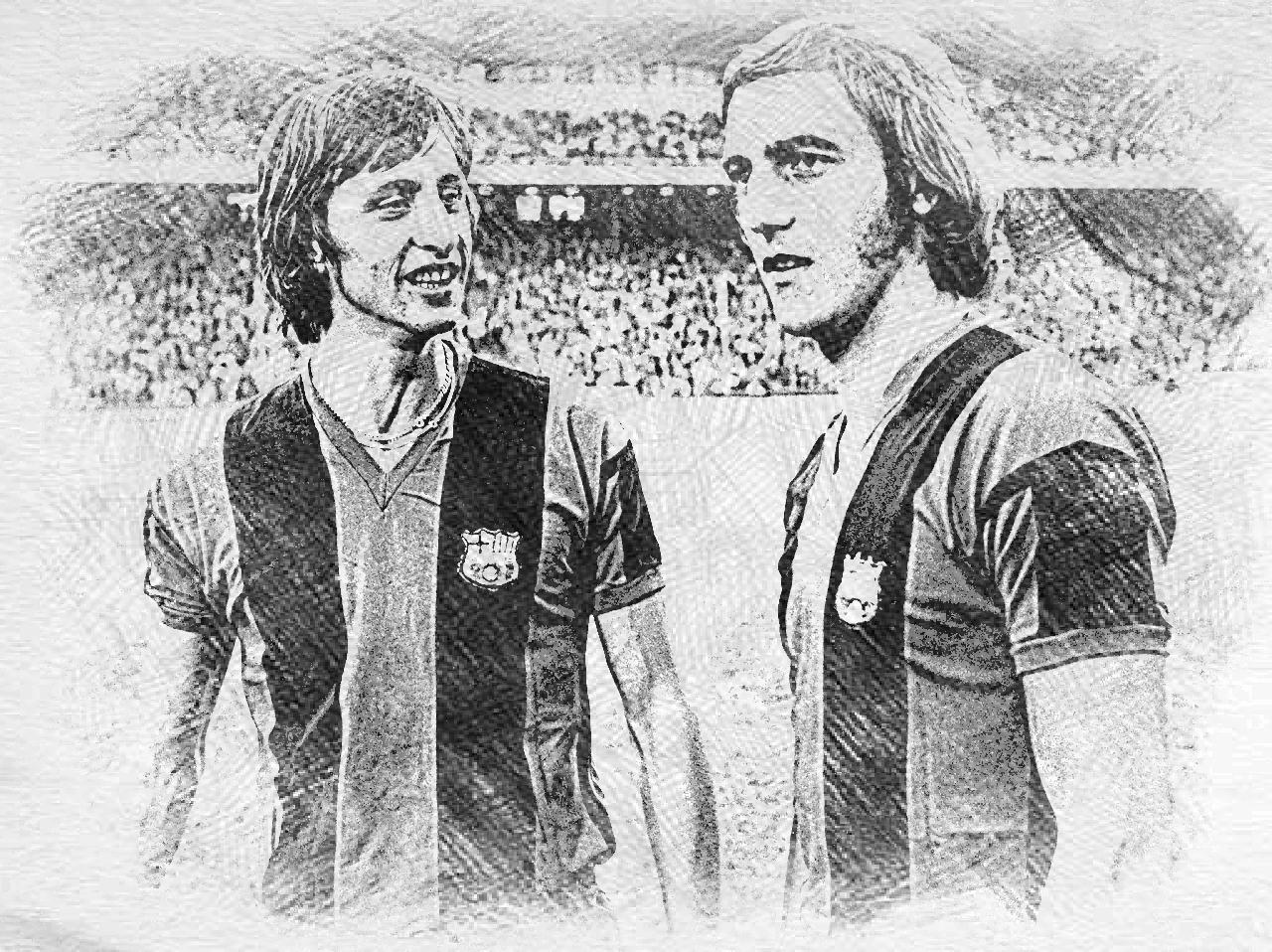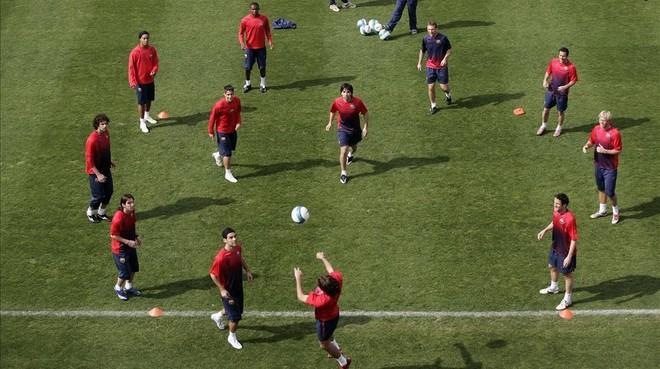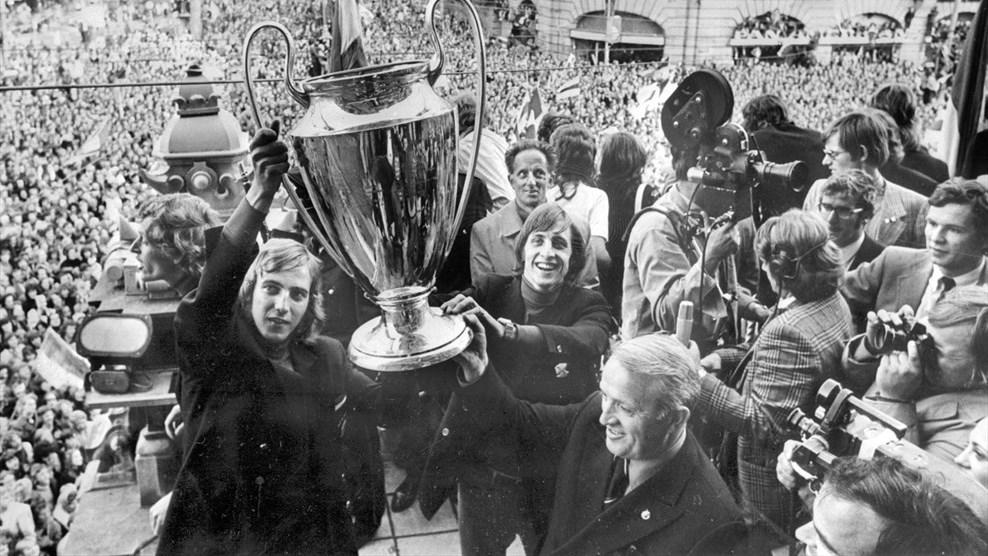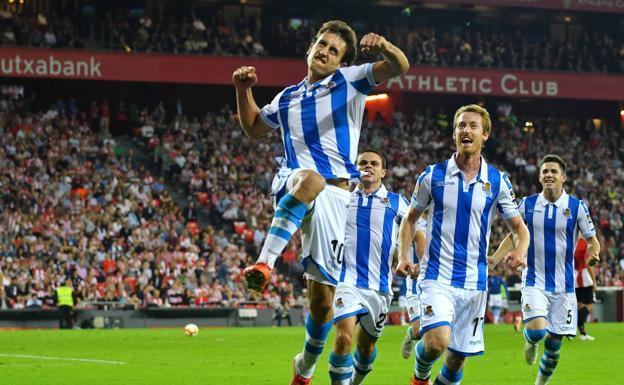
Young Devils – Total Football DNA and Two Johans
Or how to use Club DNA to keep your FM20 save interesting
The influence of Total Football has been far-reaching in both time and place. Since its dramatic entry into the world in 1974 it changed the face of the sport as we know it. Marcelo Bielsa, Jurgen Klopp and Pep Guardiola were all influenced by Johan Cruyff and Rinus Michels in 1970s Netherlands. If not for them, Spanish Tiki-Taka would not have existed. In this followup to my last introductory piece, I will expand on the practical side of Total Football and its application in FM20. But rather than dealing with the specifics of tactical instructions I will focuse on the players. If anything, defining a clear club DNA to mold your team around can be more important to the long-term effectiveness of the tactic than team instructions.
Previously on Young Devils:
What is Club DNA?
Before I begin I think I have to explain a little what I mean by “Club DNA”. It is a term that gets thrown around a lot on FM-related blogs and forums. But outside of long-term FM fans, it will probably be unfamiliar to those new to football manager. So what is it exactly and how can it help your team to win in FM20?
Club DNA is that defining features of your team that you set in stone. A sort of house rule that you want your club to follow. It can either bring a challenge or simply more focus to a long-term save. As in real life, it can be anything really. Historically, some clubs committed to transfer based DNA such as with Athletic Bilbao’s Basque only transfer policy. Usually it affects player recruitment, where club DNA will define the attributes to look for to match the club’s playing style. For instance, Barcelona dedicated themselves to promoting pressing possession style of play to the point where it became synonymous with the club. Their youth academy will try to train and develop players fit to play this type of football. And it is very unlikely that Barça manager will buy a pure target man.
Image above shows a popular training routine, el rondo, at Barcelona’s La Masia Youth Academy. It is one of many meant to make keeping possession nearly instinctual in its pupils. Some of the best playmakers in the world have graduated from Barcelona’s Academy. Attacking possession football is in their DNA.
Thus “DNA” acronym takes on a clever double meaning. Literally, the word itself means the genetic programming that is unalterable at the core of every human being. But in the context of a football club’s culture it can stand for Do Not Alter. Meaning the aspects of the club identity which cannot be altered. They are core elements which define the club and can influence everything, from the transfer policy to tactics.
At end of my 1st season with Young Devils, I started to ponder the elements of my own club’s DNA. I realized that the mission I started with might not be enough to keep me interested long-term. Unfortunately, this is always a risk with long FM saves. I am sure it led to many an abandoned save. The challenge of simply winning might be sufficient at first. But as in-game days add up, it’s normal to lose focus. I started out with a few initial goals, such as developing home-grown youth players, recreating Bielsa-style tactic and winning hardware. Yet they might not be enough to carry this save for more than a single season. Not without adding a clear club DNA to focus my recruitment and development plan that is. So as I usually do I looked to football history to seek some inspiration.
Argentina’s Darkest Hour and Birth of Bielsa-ball
Like many young Argentinean footballers growing up in 1970s, Bielsa took inspiration from Rinus Michel’s Flying Dutchmen and their “Total” victory over Argentina in 1974. Early on, Bielsa’s tactical philosophy was clearly drawn from Total Football. In his early managing days, his most used shape was a classic Dutch 4-3-3, which Cruyff’s Ajax popularized. He used it extensively at Newell’s Old Boys. Although at the time, Bielsa’s unique twist to it was already apparent. No matter the formation, Bielsa uses the same formula for his attackers, the front three in front of an enganche. Clearly you can take Bielsa out of Argentina but you cannot take Argentina out of Bielsa. The Argentinean playmaker role is the wild-card in his take on Total Football. Otherwise his style is very Dutch through and through.
Upon leaving his native country, and during the recent decade of his European tour, Bielsa has become famous for his fluid approach. It’s a practical take on Total Football, which does not require a team full of world-class players to achieve. What he requires is a nearly obsessive dedication to training routines and fitness.
With Bielsa-ball (lets call it) what may start as 4-3-3 or 4-1-4-1 becomes 3-4-3 or 4-2-3-1 as the game progresses. Bielsa always prefers having one more defender than the opponent. Thus he will change his tactics according to the opposition, requiring his midfielders to drop between the centrebacks or fullbacks to aggressively join the attackers in stretching the field and creating overloads. Stylistically, Bielsa-ball is more like Total Football than any other football seen in the last decade. Other than Barcelona’s Tiki-Taka of the first decade of 2000s.
“Football rests on four fundamentals: 1) defence, 2) attack, 3) how you move from defense to attack, 4) how you move from attack to defense. The issue is trying to make those passages as smooth as possible.” – Marcelo Bielsa
Bielsa’s answers to this dilemma are tactical versatility and rotation. Everything from his insistence on players swapping positions to having his midfielders play as defenders or wingbacks, can be traced back to the legacy of Dutch Total Football. It is very reminiscent of Ajax’s Rinus Michels’ emphasis on constant movement of players rotating and interchanging. Also like the Dutch of 1970s, Bielsa demands very intense pressing. One of the main tenets of Total Football was indeed high press. The idea being that the ball needed to be pursued with utmost intensity. The Dutch sought to make the field as small as possible when out of possession, and largest possible when attacking.
When Bielsa-ball works, it’s a whirlwind of passing, movement, interchange and improvisation resembling Total Football at its finest. Image below is an example of a typical Leeds passing map versus Sheffield Wednesday during 2019-2020 season (courtesy of Totalfootballanalysis.com). Can you count all the triangles?
Bielsa-ball also requires his players to be very fit and technically adept. This is where the need of a proper Club DNA comes in. With a tactical system as intense as Total Football or Bielsa’s take on it, it’s all about players, not instructions. Preparation starts at the training field and player attribute analysis. Success rests on how closely you are able to mold your players to Total Football template. So can it be done at Man Utd, and Total Football achieved at Old Trafford? Before I can answer that lets take a trip to the 70s when Johan was a popular name in Europe.
The Tale of Two Johans
While Johan Cruyff was the tactical brain of Total Football, Johan Neeskens was its beating heart in the midfield. He was the first truly “box-to-box” midfielder, a tireless runner with great technical skill and eye for goal. At Ajax, Dutch National Team and eventually Barcelona, Neeskens took up the central midfield role in support of Cruyff. But he helped Cruyff and his team in more than just assists.
Neeskens was very tough when it came to pressing and regaining possession. Starting his career as right-back, he was able to transition seamlessly to midfield. There he used his great fitness, skill at running and hard-tackling to great effect. In other words, a complete footballer whom Bielsa would have loved to manage.
Former Ajax team-mate Sjaak Swart called Johan Neeskens “steel-hard” midfielder “worth two men in midfield.” His fearless tenacity and grit served Rinus Michel’s philosophy perfectly. In Total Football smooth passing and flair often went hand-hand with ruthless pressing and tackling when not in possession. As Johan Cruyff, Total Football’s poster boy, lead from the front, amazing everyone with technical skills and creative artistry, it was Johan Neeskens, the tough, ferocious dynamo in both defence and attack, who did the dirty work to get the ball from the opponent. He also made most of his chances when Cruyff’s smart movement opened up space for his attacking runs. Good examples being his goals against West Germany and Argentina at both 1974 and 1978 World Cups. Total Footballer Extraordinaire!
When Ajax won the Champions League in 1971, it prompted Rinus Michels to leave for the sunny shores of Catalonia. Cruyff and Neeskens quickly followed him there to resume their epic partnership at Barça. Their chemistry remained strong as the Dutchmen won more trophies and personal accolades in Spain. It was however Johan Cruyff’s later contributions to Barcelona that forever endeared the two Johans in Barcelona fan’s psyche. He not only introduced the uniquely Dutch fluid attacking possession style to Catalonia but also forever redefined Barcelona’s Club DNA when he later managed it. Cruyff helped establish La Masia, Barça’s academy where youngsters learned to play Total Football. It is thanks to Cruyff that Barça, and Spain’s National Team, continue the legacy of Total Football to this day.
Developing The Young Devils Club DNA – The Attributes
To aknowledge Bielsa’s debt to Total Football, my Bielsa-ball DNA will reflect what I think are the three pillars of an ideal Total Footballer like Neeskens or Cruyff. Naturally such a player needs to be well-rounded, capable in playing in almost any position on the field (except keeper). By well-rounded I mean possessing at least two-digit values in all attributes required to play in attack, midfield and defence. Furthermore to excel, he will need excellent technical skills; primarily Technique, Passing, Dribbling and First Touch. He needs to be a hardworking team player who is capable of intelligently reading the play at any given time. The former can be summed up in Teamwork and Workrate. While the latter are a combination of Vision, Decision, Anticipation, Positioning and Off the Ball – his Football Brain.
The above view gives a good idea of how the Man Utd team fits the Total Football style. There are a lot of green and orange numbers which is very good. It definitely gives me something to work with. Yet there are also gaping holes in key areas such as positioning and vision, which will need to be addressed. In due time.
When trying to redefine the identity of your club to reflect a particular DNA, one cannot act hastily. It can be disastrous for team morale if you try to get rid of many players at once. Even if it is to send them on loans. Caution and patience is required, as you phase out those who do not match club’s new identity over 2-3 seasons. I haven’t identified who will need to move on, but expect the next two summer transfer periods to be busy. Luckily I start the summer with 120 million pound transfer budget. Some new faces will need to be brought in.
Searching for a Perfect Total Footballer
After defining the key attributes, the next step in creating a new Club DNA, is identifying the Core players. These are the players around which you will build your tactical system. In a counter-attacking system, they might be your fastest wingers. While in one based around heavy possession they will be your top play-makers. Not suprisingly this task can be very difficult for a Total Football-inspired system. The ideal core player for such a system, is basically a very-well rounded jack of all trades like Johan Neeskens. So for Manchester United the search is on!
One player that I have had my eye on for a while, is Real Sociedad’s golden boy, Mikel Oyarzabal. Sociedad are asking a pretty penny for his services, but in my opinion he is more than worth it. Mikel is probably one of the most uniquely complete footballers currently in FM20.

As you can see he remarkably possesses 13-14+ values across all attributes! Literally you could slot him into any position or role and except him to perform well in it. If that was not enough, take a look at his partner in midfield, and incidentally another Mikel (although looking at his attributes, might as well call him Neeskens).
So even if Oyarzabal is not quite Cruyff, the two Mikels together could give Man Utd the core that it needs to build the rest of team around. Could the two Mikels do for Manchester what two Johans did for Barça? Only my next article could show 😉
To Be Continued…
Also in my next article, I will show how Bielsa-ball DNA is taking root at Old Trafford. The preparation work for the second season has started, on the tactical board, training field and in the transfer market. I have also made some changes to the Hammer and Anvil tactic which I will discuss at length. Hope you enjoyed my series so far and continue to follow it as it develops! And my Young Devils continue their journey from U23 to Champions League glory!
Here is my custom Bielsa-ball player view: https://ufile.io/ebgektoi











6 thoughts on “Young Devils – Total Football DNA and Two Johans”
This is a great article. I have been using a biesla/total football system myself and loving it. I have found that the most important attributes for club DNA is work rate, aggression, stamina, nat fitness. Then I look at the other mental attributes you’ve listed and then technical attributes.